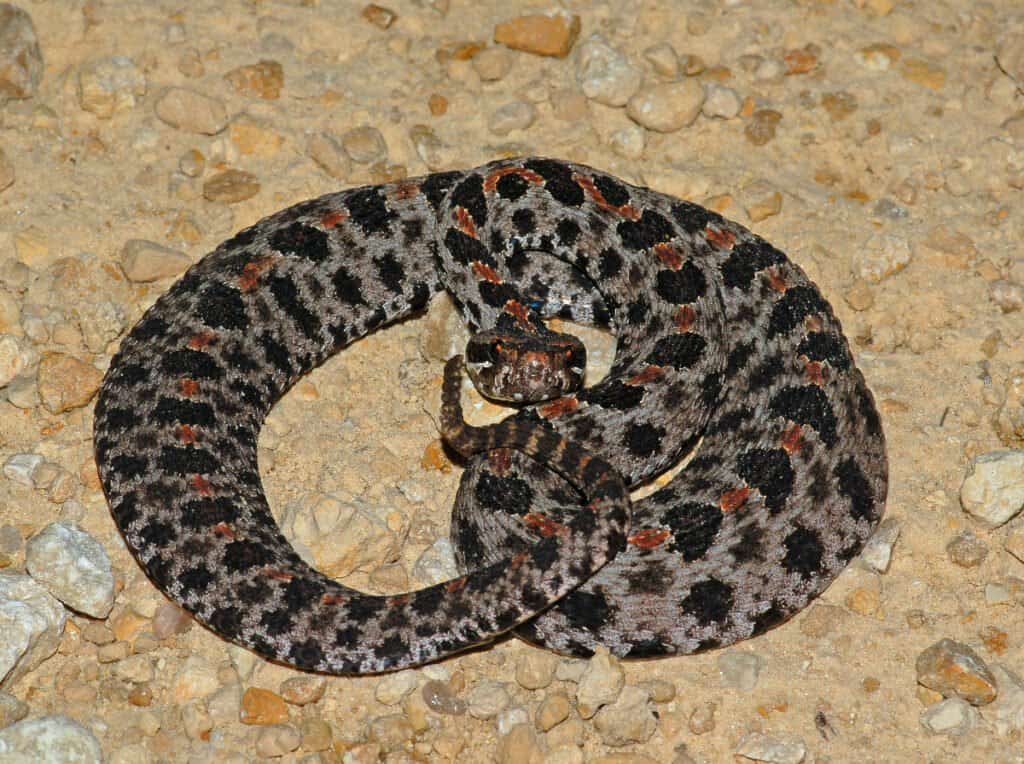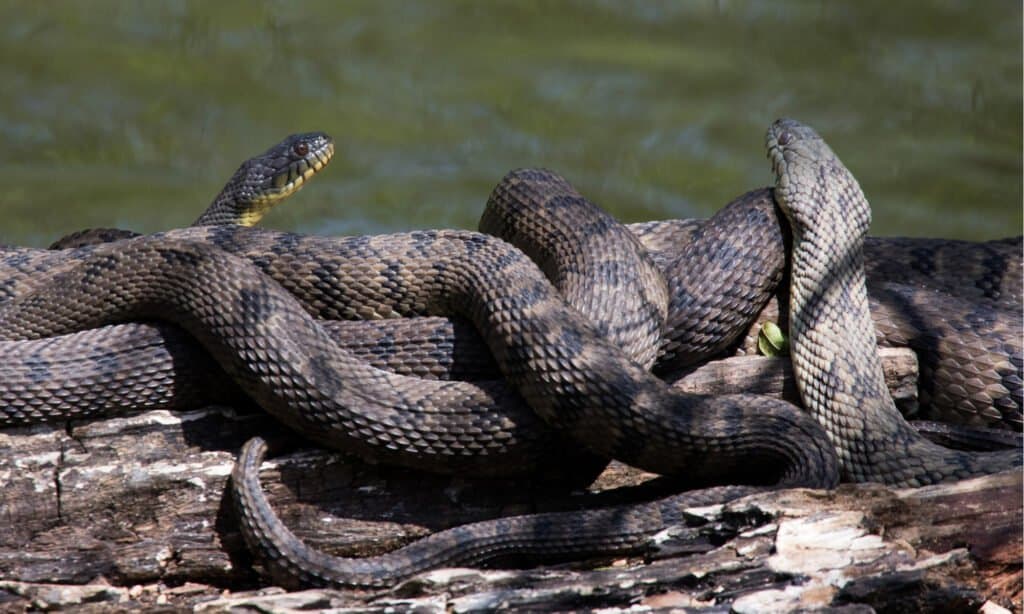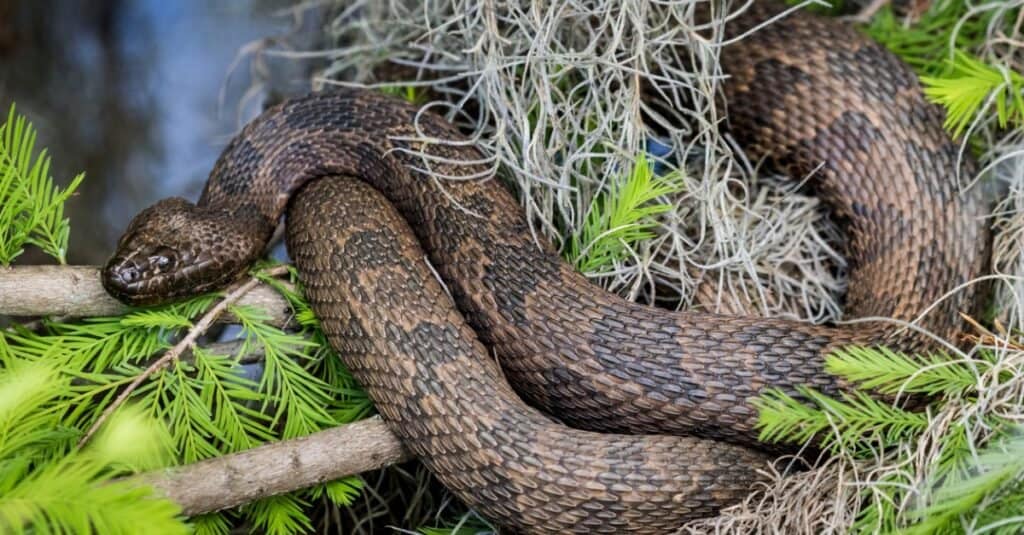Alabama is a relatively warm state, providing an exceptional home for at least 43 species of snakes. With so many snakes, it is understandable why many people may fear or dislike these reptiles. However, both venomous and nonvenomous snakes are extremely beneficial in Alabama, helping to control rodents and other pests that spread diseases. Only six of the 43 species of snake in Alabama are venomous. Five of these are pit vipers and three of these pit vipers are rattlesnakes.
Rattlesnakes are easy to identify by the rattle at the end of their tails. They also have large, shield-shaped or triangular-shaped heads with pits between their eyes and noses, as well as vertical pupils. So, what types of rattlesnakes are in Alabama?

1. Timber Rattlesnake

Timber rattlesnakes are very common all throughout Alabama.
©Frode Jacobsen/Shutterstock.com
| Timber Rattlesnake | |
|---|---|
| Range | All of Alabama |
| Length | 36-54 inches |
The timber rattlesnake is the most common rattlesnake in Alabama and can be found all throughout the state. In northern Alabama, this snake is called the “Timber Rattlesnake,” while in southern Alabama is it often called the “Canebrake Rattlesnake.” These snakes live in woodlands and forest areas, rocky outcrops, and cane thickets. They tend to be more docile, but are highly venomous and should be left alone.
Timber rattlesnakes have heavy bodies with broad heads and thin necks. The longest timber rattlesnake recorded was six and a half feet long! However, these snakes are usually closer to 3-5 feet in length. Timber rattlesnakes are gray or tan with dark brown or black bands along the length of their bodies. Many timber rattlesnakes in Alabama have a thin brown or reddish-brown stripe running along the middle of their backs, in between the dark bands. Their large bodies end with a short and thick black tail and light-colored rattle. These snakes primarily eat mice, squirrels, and chipmunks, although sometimes they may hunt frogs and birds. In the winter they brumate (like hibernating), sleeping in old stumps, rocks, and burrows made by mammals.
2. Pygmy Rattlesnake

Pygmy rattlesnakes are a small rattlesnake species.
©Gerald A. DeBoer/Shutterstock.com
| Pygmy Rattlesnake | |
|---|---|
| Range | All of Alabama except for northeastern Alabama |
| Length | 16-24 inches |
The pygmy rattlesnake lives in southern, central, and northwestern Alabama. In other words, this snake is found all throughout Alabama, except for in the northeast. These snakes prefer woodland, forest, or scrubland habitats. They can also be found in areas with water like marshes or near rivers. Pygmy rattlesnakes are smaller than most rattlesnakes, growing to only 16-24 inches in length. These snakes have thickset bodies that are light gray, dark gray, dark brown, or copper-colored. They have black oval spots or blotches along their backs, black spots along their sides, and two dark bands along both sides of their faces. They also have an orange or rust-colored stripe running along the top middle of their backs.
3. Eastern Diamondback Rattlesnake

Eastern diamondback rattlesnakes’ pattern often fades towards their tail.
©Chase D’animulls/Shutterstock.com
| Eastern Diamondback Rattlesnake | |
|---|---|
| Range | Southern & South-Central Alabama |
| Length | 48-84 inches |
The eastern diamondback rattlesnake lives in southern and south-central Alabama, favoring forest, woodland, and marshy areas, as well as deserted farmland and overgrown fields. In Alabama, the eastern diamondback rattlesnake is considered a Species of High Conservation Concern. These snakes spend the winter in old stumps and gopher tortoise burrows. Unfortunately, snake hunters have been known to gas gopher tortoise burrows, killing both snakes and tortoises.
Eastern diamondback rattlesnakes are the largest venomous snake in Alabama, and the longest rattlesnake species in the world, growing just over 7 feet in length. However, snakes measuring 4-5 feet long are much more common. Eastern diamondback rattlesnakes have gray or brown heavy bodies, with diamond patterns on their backs and running along the length of their bodies. These diamond markings have yellow outlines with brown and black centers. The eastern diamondback rattlesnake also has a dark cheek-stripe on either side of its face. This stripe runs from each eye to the back of the mouth and is bordered by a white or cream color.
The eastern diamondback rattlesnake it not nearly as aggressive as the western diamondback rattlesnake. When it senses danger, this snake will freeze and remain motionless until the danger has passed. However, this snake will fight back if it is touched or feels threatened. The eastern diamondback rattlesnake eats small mammals like rats, mice, rabbits, and squirrels. When hunting, it coils its body and waits to strike. Astonishingly, eastern diamondback rattlesnakes can hold their bodies in this coiled position for up to one whole week!
Summary of 3 Types of Rattlesnakes in Alabama
Here’s a recap of the three rattlesnake species found in Alabama that we looked at.
| Number | Rattlesnake | Range | Length |
|---|---|---|---|
| 1 | Timber Rattlesnake | All of Alabama | 36-54 inches |
| 2 | Pygmy Rattlesnake | All of Alabama except for northeastern Alabama | 16-24 inches |
| 3 | Eastern Diamondback Rattlesnake | Southern & South-Central Alabama | 48-84 inches |
Rattlesnake Look-a-Likes in Alabama
While there are only three types of rattlesnakes in Alabama, there are many nonvenomous snakes that can be mistaken for rattlesnakes because of their appearance—except, of course, they do not have a rattle at the end of their tails.
Diamondback Water Snake

Diamondback water snakes are not venomous but they can bite hard.
©Laurie L. Snidow/Shutterstock.com
| Diamondback Water Snake | |
|---|---|
| Range | Western Alabama |
| Length | 36-54 inches |
The diamondback water snake lives in Western Alabama in and near water, like creeks, ponds, canals, marshes, swamps, lakes, and rivers. This snake eats aquatic animals like toads, frogs, tadpoles, salamanders, small fish, and crayfish. Diamondback water snakes are 3-5 feet long with thick bodies that are brown or olive green. They have rough, keeled scales and dark diamond markings along their backs. Because of their appearance, they are often mistaken for venomous snakes like the eastern diamondback rattlesnake. Although the diamondback water snake is not venomous, it is quite aggressive and can bite repeatedly if it feels trapped.
Brown Water Snake

The dark brown patches on a brown water snake’s back on larger than those on its sides.
©iStock.com/csraphotography
| Brown Water Snake | |
|---|---|
| Range | Southeast corner of Alabama |
| Length | 30-55 inches |
The brown water snake is another reptile that lives in and near the water, but only in the southeast corner of Alabama. These snakes are 30-55 inches long and are often found in larger rivers where they eat catfish. Brown water snakes are tan or brown with dark square-shaped blotches along their backs. These snakes enjoy resting on or hanging upside down from tree branches above the water. Brown water snakes are nonvenomous, but they are often mistaken for venomous snakes like rattlesnakes and cottonmouth snakes.
Gray Rat Snake

Gray rat snakes are sometimes called chicken snakes or pilot black snakes.
©dkHDvideo/Shutterstock.com
| Gray Rate Snake | |
|---|---|
| Range | All of Alabama |
| Length | 36-72 inches |
The gray rat snake lives throughout Alabama. However, it is more common in the southern areas of the state. These snakes are commonly seen in agricultural areas, as well as high up in trees. Gray rat snakes in southern Alabama are often lighter in color than those living in other areas. These snakes are gray with dark blotches along their backs, making them sometimes look like timber rattlesnakes in Alabama. However, gray rat snakes are nonvenomous and do not have rattles.
The photo featured at the top of this post is © iStock.com/Wide-River-Rick
Discover the "Monster" Snake 5X Bigger than an Anaconda
Every day A-Z Animals sends out some of the most incredible facts in the world from our free newsletter. Want to discover the 10 most beautiful snakes in the world, a "snake island" where you're never more than 3 feet from danger, or a "monster" snake 5X larger than an anaconda? Then sign up right now and you'll start receiving our daily newsletter absolutely free.
Thank you for reading! Have some feedback for us? Contact the AZ Animals editorial team.






